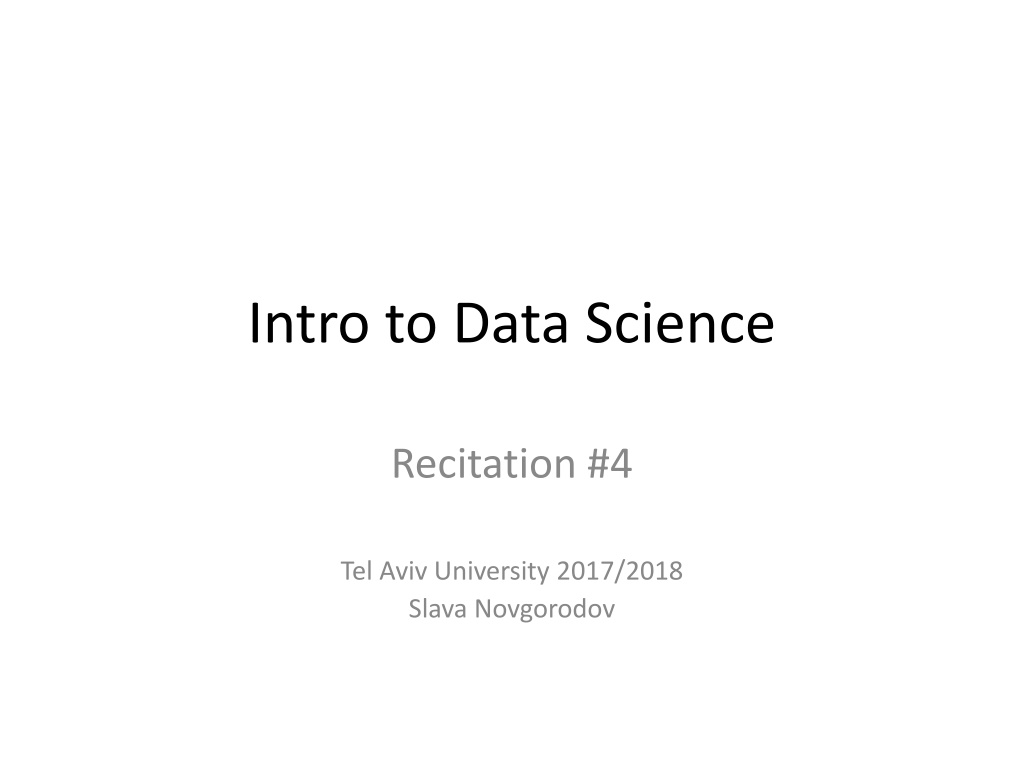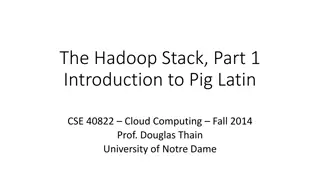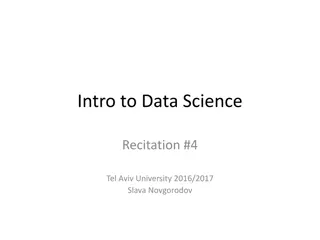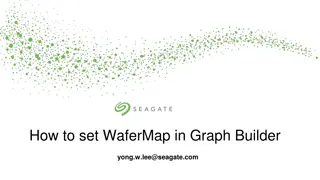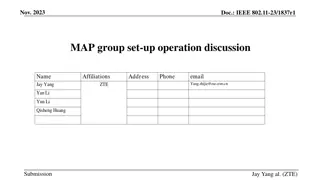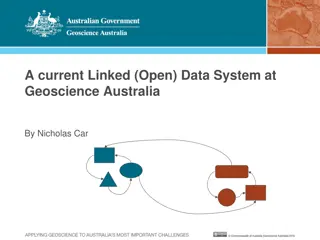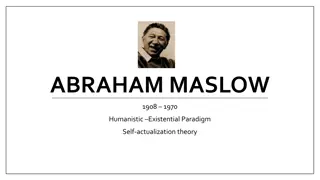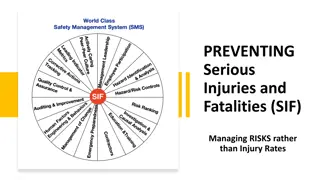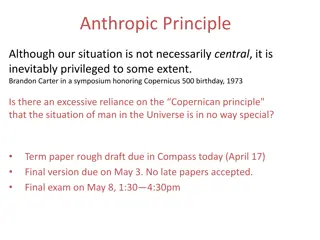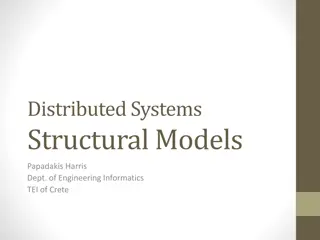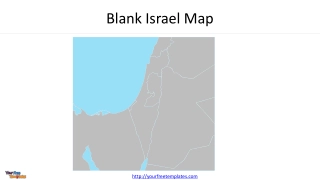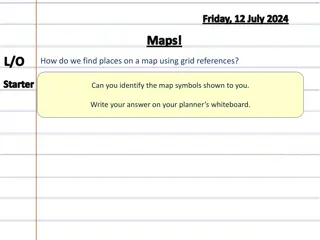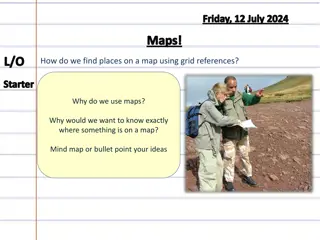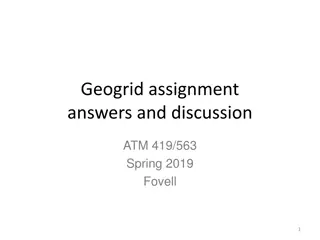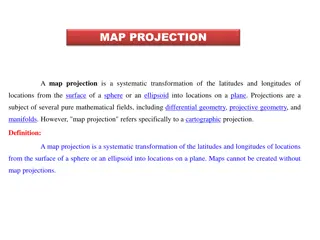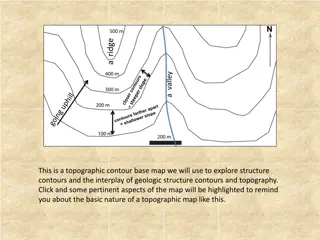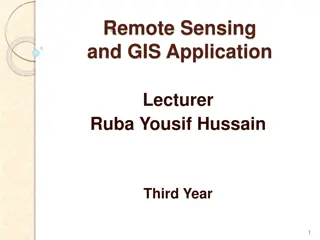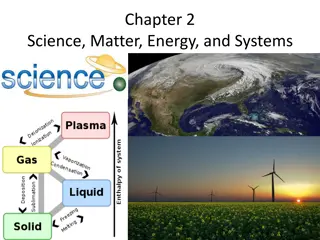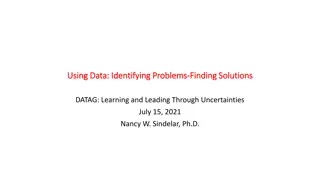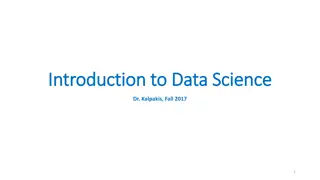Introduction to Map Reduce Paradigm in Data Science
Explore the MapReduce paradigm in data science through examples, discussions on when to use it, and implementation details. Understand how MapReduce is utilized for processing and generating big data sets efficiently.
Download Presentation

Please find below an Image/Link to download the presentation.
The content on the website is provided AS IS for your information and personal use only. It may not be sold, licensed, or shared on other websites without obtaining consent from the author. Download presentation by click this link. If you encounter any issues during the download, it is possible that the publisher has removed the file from their server.
E N D
Presentation Transcript
Intro to Data Science Recitation #4 Tel Aviv University 2017/2018 Slava Novgorodov
Todays lesson Introduction to Data Science: Map Reduce Paradigm Recall Examples Connection to previous parts of the course MapReduce vs. Spark Discussion Examples
MapReduce Paradigm MapReduce is a programming model and an associated implementation for processing and generating big data sets with a parallel, distributed algorithm on a cluster Map() performs filtering and sorting Reduce() performs a summary operation
When to use MapReduce? Problems that are huge, but not hard Problems that easy to parallelize (easily partitionable and combinable) You should only implement Map and Reduce!
Example The Hello, World! of Map Reduce WordCout Given a file with many rows, find how many times each word appears in the whole file Output: this, 2 is, 2 first, 1 line, 3 and, 2 second, 1 another, 1 Input: this is first line and this is second line and another line 5
Example solution The Hello, World! of Map Reduce - WordCout 6
WordCount implementation Map: def mapfn(k, v): for w in v.split(): yield w, 1 Reduce: def reducefn(k, vs): result = sum(vs) return result This particular implementation is in Python (as the rest of the recitation). Java, Scala and other languages are also supported. It s not important to remember the syntax, remember the pseudo-code
Running our first MapReduce The default option Hadoop (installed on TAU servers) Installing Hadoop distribution from a Docker Lightweight mode Python simulator e.g. https://github.com/ziyuang/mincemeatpy
Running on Hadoop hadoop \ jar <path_to_hadoop.jar> \ -mapper "python mapper.py" \ -reducer "python reducer.py" \ -input "wordcount/mobydick.txt" \ -output "wordcount/output" For the simplicity, we will use the python simulator of MapReduce.
Social Networks example Task: Find all mutual friends of all pairs of users Input: A -> B C D B -> A C D E C -> A B D E D -> A B C E E -> B C D Output: ('A', 'D') -> {'B', 'C } ('A', 'C') -> {'D', 'B } ('A', 'B') -> {'D', 'C } ('B', 'C') -> {'D', 'A', 'E } ('B', 'E') -> {'D', 'C } ('B', 'D') -> {'A', 'C', 'E } ('C', 'D') -> {'A', 'B', 'E } ('C', 'E') -> {'D', 'B } ('D', 'E') -> {'B', 'C'}
Social Networks example - solution Solution: friends.py Map: def mapfn(k, v): Reduce: def reducefn(k, vs): d = v.split("->") friends = set(d[1].strip().split(" ")) for w in friends: first = d[0].strip() second = w if first > second: ret = vs[0] for s in vs: ret = ret.intersection(s) return ret temp = first first = second second = temp yield (first, second), friends
Social Networks example - data Data: https://snap.stanford.edu/data/egonets-Facebook.html The format is not the same as in previous example. How we will convert it to the same format?
Crawling and incoming links Task: Find all incoming links for web-pages Input: A.com -> B.com C.com B.com -> D.com E.com C.com -> A.com E.com D.com -> A.com E.com E.com -> D.com Output: A.com -> ['C.com', 'D.com'] B.com -> ['A.com ] C.com -> ['A.com ] E.com -> ['B.com', 'C.com', 'D.com ] D.com -> ['B.com', 'E.com']
Incoming links example - solution Solution: incoming_links.py Map: def mapfn(k, v): Reduce: def reducefn(k, vs): d = v.split("->") pages = set(d[1].strip().split(" ")) for w in pages: yield w, d[0].strip() return vs
Important tokens in search queries Task: Find all important tokens in search queries Input: cheap smartphone new movies smartphone interesting movies Output: cheap REGULAR smartphone IMPORTANT new REGULAR movies IMPORTANT
Important tokens example - solution Solution: important_tokens.py Map: def mapfn(k, v): Reduce: def reducefn(k, vs): if PART in vs and FULL in vs: return k, IMPORTANT return k, REGULAR d = v.split("->") tokens = set(d[1].strip().split(" ")) type = PART if (len(d) == 1): type = FULL for w in tokens: yield w, type
Most popular term in search queries With MapReduce easy What if we have only one machine with super- limited memory - like we can store only 5 words and 5 counters. And we want to find 5 most popular search terms. Ideas?
Most popular term in search queries Solution: Misra-Gries algorithm for approximate counts on streams Model the queries terms as a stream and maintain the counters. If a counter for a specific term exists increment If there is no counter for a term, but still enough memory add new counter If there is no memory, decrement every counter by 1, remove 0 counters
Misra-Gries step-by-step K = 2 Stream = cheap, blue, smartphone, Barcelona, cheap, cheap, Barcelona, smartphone, cheap, Barcelona, cheap, Barcelona, smartphone, blue, cheap, Barcelona , Processing now: cheap Memory: {(cheap, 1)}
Misra-Gries step-by-step K = 2 Stream = cheap, blue, smartphone, Barcelona, cheap, cheap, Barcelona, smartphone, cheap, Barcelona, cheap, Barcelona, smartphone, blue, cheap, Barcelona , Processing now: blue Memory: {(cheap, 1), (blue,1)}
Misra-Gries step-by-step K = 2 Stream = cheap, blue, smartphone, Barcelona, cheap, cheap, Barcelona, smartphone, cheap, Barcelona, cheap, Barcelona, smartphone, blue, cheap, Barcelona , Processing now: smartphone Memory: {(cheap, 0), (blue,0)}
Misra-Gries step-by-step K = 2 Stream = cheap, blue, smartphone, Barcelona, cheap, cheap, Barcelona, smartphone, cheap, Barcelona, cheap, Barcelona, smartphone, blue, cheap, Barcelona , Processing now: Barcelona Memory: {(Barcelona,1)}
Misra-Gries step-by-step K = 2 Stream = cheap, blue, smartphone, Barcelona, cheap, cheap, Barcelona, smartphone, cheap, Barcelona, cheap, Barcelona, smartphone, blue, cheap, Barcelona , Processing now: cheap Memory: {(Barcelona,1), (cheap,1)}
Misra-Gries step-by-step K = 2 Stream = cheap, blue, smartphone, Barcelona, cheap, cheap, Barcelona, smartphone, cheap, Barcelona, cheap, Barcelona, smartphone, blue, cheap, Barcelona , Processing now: cheap Memory: {(Barcelona,1), (cheap,2)}
Misra-Gries step-by-step K = 2 Stream = cheap, blue, smartphone, Barcelona, cheap, cheap, Barcelona, smartphone, cheap, Barcelona, cheap, Barcelona, smartphone, blue, cheap, Barcelona , Processing now: Barcelona Memory: {(Barcelona,2), (cheap,2)}
Misra-Gries step-by-step K = 2 Stream = cheap, blue, smartphone, Barcelona, cheap, cheap, Barcelona, smartphone, cheap, Barcelona, cheap, Barcelona, smartphone, blue, cheap, Barcelona , Processing now: smartphone Memory: {(Barcelona,1), (cheap,1)}
Misra-Gries step-by-step K = 2 Stream = cheap, blue, smartphone, Barcelona, cheap, cheap, Barcelona, smartphone, cheap, Barcelona, cheap, Barcelona, smartphone, blue, cheap, Barcelona , Processing now: cheap Memory: {(Barcelona,1), (cheap,2)}
Misra-Gries step-by-step K = 2 Stream = cheap, blue, smartphone, Barcelona, cheap, cheap, Barcelona, smartphone, cheap, Barcelona, cheap, Barcelona, smartphone, blue, cheap, Barcelona , Processing now: Barcelona Memory: {(Barcelona,2), (cheap,2)}
Misra-Gries step-by-step K = 2 Stream = cheap, blue, smartphone, Barcelona, cheap, cheap, Barcelona, smartphone, cheap, Barcelona, cheap, Barcelona, smartphone, blue, cheap, Barcelona , Processing now: cheap Memory: {(Barcelona,2), (cheap,3)}
Misra-Gries step-by-step K = 2 Stream = cheap, blue, smartphone, Barcelona, cheap, cheap, Barcelona, smartphone, cheap, Barcelona, cheap, Barcelona, smartphone, blue, cheap, Barcelona , Processing now: Barcelona Memory: {(Barcelona,3), (cheap,3)}
Misra-Gries step-by-step K = 2 Stream = cheap, blue, smartphone, Barcelona, cheap, cheap, Barcelona, smartphone, cheap, Barcelona, cheap, Barcelona, smartphone, blue, cheap, Barcelona , Processing now: smartphone Memory: {(Barcelona,2), (cheap,2)}
Misra-Gries step-by-step K = 2 Stream = cheap, blue, smartphone, Barcelona, cheap, cheap, Barcelona, smartphone, cheap, Barcelona, cheap, Barcelona, smartphone, blue, cheap, Barcelona , Processing now: blue Memory: {(Barcelona,1), (cheap,1)}
Misra-Gries step-by-step K = 2 Stream = cheap, blue, smartphone, Barcelona, cheap, cheap, Barcelona, smartphone, cheap, Barcelona, cheap, Barcelona, smartphone, blue, cheap, Barcelona , Processing now: cheap Memory: {(Barcelona,1), (cheap,2)}
Misra-Gries step-by-step K = 2 Stream = cheap, blue, smartphone, Barcelona, cheap, cheap, Barcelona, smartphone, cheap, Barcelona, cheap, Barcelona, smartphone, blue, cheap, Barcelona , Processing now: Barcelona Memory: {(Barcelona,2), (cheap,2)}
Misra-Gries step-by-step K = 2 Stream = cheap, blue, smartphone, Barcelona, cheap, cheap, Barcelona, smartphone, cheap, Barcelona, cheap, Barcelona, smartphone, blue, cheap, Barcelona , Output: {(Barcelona,2), (cheap,2)} Real counts: {(cheap,6), (Barcelona,2), (smartphone,3), (blue,2)} The Top-K is the same! In worst case may be wrong, depends on a stream. For theoretical results: http://www.cs.utexas.edu/users/misra/scannedPdf.dir/FindRepeatedElements.pdf
Pseudo-synonyms Data queries: buy cheap house buy big house buy new house rent cheap car rent new car rent Volkswagen car Desired output: cheap new (2) Ideas? How many M/R stages needed? implementation HW
K-Means Recall from Recitation 2 Used for clustering of unlabeled data Example: Image compression
K-Means animation Very good animation here: http://shabal.in/visuals/kmeans/2.html
K-Means on MapReduce Data points (x,y) in [0,1]x[0,1]: 0.72 0.44 0.16 0.82 0.42 0.37 0.19 0.65 Desired output: (0.72 0.44) (0.55 0.83) (0.16 0.82) (0.55 0.83) (0.42 0.37) (0.29 0.16) Python implementation HW
K-Means solution sketch Map: See if there is centroids in a file, if no, generate randomly k points. On map stage, check for each point the closest c1 (0.72 0.44) c2 (0.16 0.82) c3 (0.42 0.37) c2 (0.19 0.65) Reduce: Calculate new centroids, see if there are point that want to change Important note: the algorithm is iterative and should run until stopping condition reached (Which stopping condition?) implementation HW
MapReduce disadvantages Iterative tasks that needs to be executed again and again (such as many ML algorithms), will store intermediate results on the hard drive, i.e. we will pay I/O for storing useless data Map Reduce executes JVM on each iteration hence we have some constant running cost To solve such tasks, we can use Spark, which generalizes the MapReduce idea, and saves on unnecessary I/O
When still should we use Hadoop? How fast you need your results? Examples: You process updated data once a day and data should be ready next day for reviews or analysis. Application that sends recommended products to subscribers When you have longer time say a week or 2 weeks to process data. If you can afford longer data processing latency, it will be much cheaper . If you buy an expensive server that process data in 30 minutes and the rest 23 hours 30 minutes is idle, you can buy a cheaper server and process data in say 8 hours (e.g. overnight)
